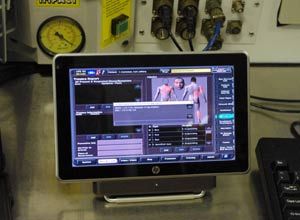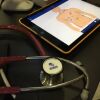A combination of hardware and software, Disaster Relief and Emergency Medical Services (DREAMS) enables advanced communications between EMS and the ER in real time.
DREAMS was originally developed as a military research project using $14 million in funding through U. S. Army Materiel Command and the Telemedicine and Technology Research Center (TATRC), in conjunction with Texas A&M University and the University of Texas Science Health Center.
The system was in use for several years on five ambulances in Liberty County, Texas. Last month I was invited to take a tour of one of these ambulances in Houston, Texas. It is arguable the most sophisticated example of a working telemedicine system in EMS. After I got a close look at DREAMS, I called up and talked to two Paramedics who actually used it.
Mike Koen, EMT-B and Executive Director at Liberty County EMS, was part of a project in conjunction with Texas A&M University and Memorial Herman. At the start of the project, the idea was to “prove that mobile telecommunications in a moving ambulance was feasible.”
“We proved that because it works, and it works very well,” Koen said.
“The biggest benefit is improved survivability,” Koen added. “First by providing better support and then later by driving the development of better training to match the new advanced skill demands. EMS is rapidly evolving and telemedicine in EMS is the next logical step.”
He reported about how they used the DREAMS ambulance during Hurricane Katrina, and also told me the story of how two of them were pulled into the bay to replace a closed ER during Rita.
It was during Rita when a PA on the DREAMS ambulance linked up with famed Trauma Surgeon James Henry “Red” Duke, Jr. at Herman Memorial for a live telemedicine consultation during a difficult hand repair.
DREAMS offers direct live transmission of voice and video, along with prioritized patient physiologic data, including 12-lead ECG, blood gases, ultrasound, e-PCR, EHR, blood pressure, and more.
The installed hardware includes a touch screen panel and portable user interface, two roof mounted cameras, headset communications, two bar code readers for scanning supplies used, and even a card scanner. Swipe a patient’s driver’s license or credit card and their name, age, and maybe address shows up instantly on your patient record.
DREAMS stores all this data in the ambulance. If it loses communications due to physical location or bandwidth limitations, it will save all data until communications are re-established. Then it sends all the saved data and updates your destination on current status, sending the most relevant data first (like the ECG on a chest pain patient).
All of this data instantly populates the e-PCR, and you can stop constructing narrative from memory to complete the chart. Since many large regions use established e-PCR systems, DREAMS can also integrate and populate other e-PCR systems.
It offers remarkable flexibility. If the ER doctor wants an updated BP, he doesn’t have to ask you to take it. They can just push a button on their screen and initiate another BP reading in your truck, because the multi-parameter monitor talks to DREAMS. If he wants to increase the tidal volume on your ventilator, once again he can do it remotely without bothering you when you have your hands full. When he gives a med order he can also instant message you the exact dosage in text form to confirm the order and reduce the potential for communications errors.
 Image Dan White |
On the ER’s HP touch screen, doctors can even use a stylus to circle where they want your attention. They can pan, tilt, and zoom the cameras remotely if they want to take a closer look at something. The whole idea is to improve and streamline communications through interconnectivity, and the test DREAMS system in Liberty County only had one real limitation: it only worked with one destination hospital and was intended primarily for trauma.
In this case, only Memorial Herman was connected. The hospital had two big screens, one showing live video and one showing all the physiological data. The layout of the ambulance components was clearly designed with the input of working street professionals.
During my tour of the Liberty County DREAMS ambulance I was amazed how cleverly everything was placed. The cameras covered the action from different angles, yet both were well out of potential head strike zones. The printer was tucked up front out of the way, and the two bar code scanners were exactly where your hands would be naturally when pulling down supplies. The card scanner was right at the head end attendant seat.
Liberty County EMS Paramedic Supervisor Johnny Spurlock, EMT-P, also worked on the DREAMS ambulances, and I asked him what he thought the major benefits of the system were.
“DREAMS was designed to give us access to a Trauma Surgeon in the field. It was great knowing you could count on them to watch your back,” he said.
I asked him if he also saw potential for this technology to help select the best destination for cardiac patients and he said it most definitely would. I asked him if he wished he still had the system operational again with all the area hospitals able to receive data from it. Not a half-second elapsed before he answered, “Yes I do.”
In years to come, telemedicine systems like DREAMS will protect first responders by documenting what they did and under exactly what kind of circumstances. They will streamline and improve communications while re-distributing valuable time. They will give our Medical Directors real-time tools to better support their EMS professionals. Telemedicine also has the potential to improve the utilization of diminishing healthcare resources. It will help patients get the care they need when they need it.
For all of these reasons and more, these kinds of systems will become commonplace in EMS; it’s just a matter of time before they do.
DREAMS and Liberty County EMS have led the way by proving that telemedicine works.
For more information about DREAMS, visit the official LifeBot website.












